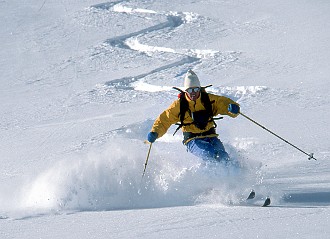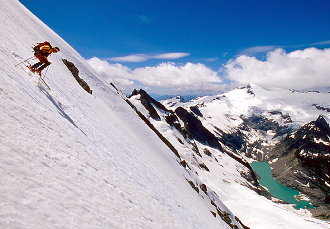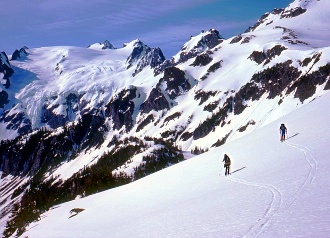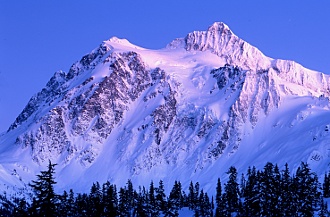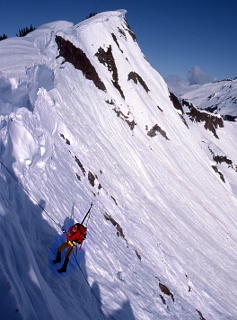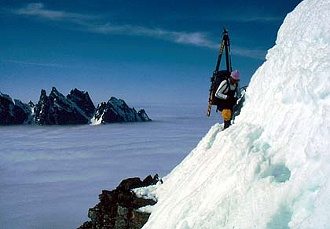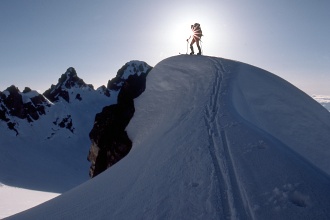
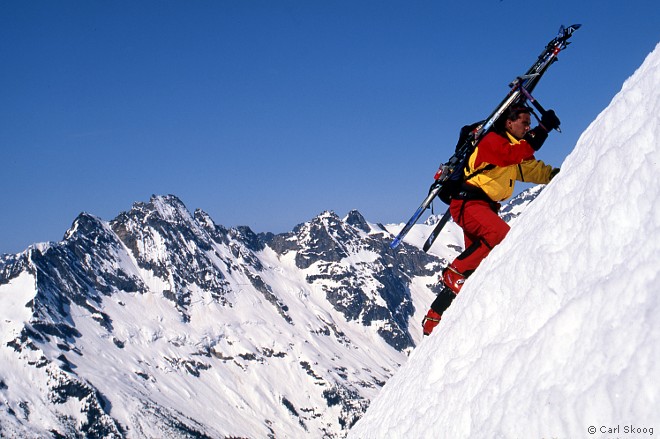
|
|
In 2010, I contributed words and images for the book Fifty Classic
Ski Descents in North America (Wolverine Publishing, Colorado). The
authors sent questions by email and used a portion of my response in the
book. This is the complete, unedited interview. Above: Rene Crawshaw climbs
Black Peak for a ski descent in 1997. Photo by Carl Skoog.
Profile Lowell Skoog, age 53
Growing up ski hill/ or local favorite My father was an old-time ski jumper and a founding stockholder at Crystal Mountain, which opened in the winter of 1962-63. I started skiing there shortly after the ski area opened. I skied at Snoqualmie Pass in high school, because it was closer and cheaper than Crystal. I started ski instructing at Ski Acres (now Summit Central) at age 15 and was PSIA full-certified at 16. Crystal Mountain remains my favorite ski area today. Favorite ski destinations I’m essentially a local skier, which means skiing in the Cascades and Olympics of Washington. I think skiing locally will be increasingly important as we get serious about dealing with climate change. My favorite mountains are the North Cascades between Snoqualmie Pass and the Canadian border. For decades these mountains have been known as “The American Alps.” When did you start skiing — share an early story I started backcountry skiing in 1979, right after I graduated from college. I did a little cross-country skiing before that, but in the spring of 1979 I bought some Ramer alpine touring bindings and mounted them on a pair of used K2 skis from my brother Gordy. My climbing mentor Gary Brill gave me an old pair of strap-on climbing skins, basically the same sort of skins they used in World War II. After making custom toe wires for my Ramers so they would stay on my leather climbing boots, I was set for backcountry skiing. In the Northwest in 1979, very few people skied the backcountry on alpine touring gear. Most of the younger backcountry skiers were on telemark gear. It has been interesting to watch the balance tip the other way during the past ten to twenty years. Today I think alpine touring is definitely more widespread. One of my earliest alpine touring trips was to Bonanza Peak in the Glacier Peak Wilderness. Bonanza is the highest non-volcanic peak in Washington and my brother Gordy, Mark Bebie and I made its first winter ascent in December 1979. This provided an early lesson in the value of skis as tools for mountaineering. For about a decade I did all my backcountry skiing, including week-long trips carrying all my gear, in climbing boots. The all-plastic boots introduced by Koflach and Kastinger in the early 1980s became standard equipment for our group. These boots had no buckles (laces only) and no high-back or any way to lock the cuff. My friends and I became good at skiing in them and today I find that most backcountry ski boots are stiffer than I need or want. We didn’t own avalanche beacons (hardly anyone did) and I took my first avalanche class in 1980. Basically we were conservative about avalanche conditions because techniques like the rutchsblock, compression test, and others weren’t widely known. Skiing bio — list ski descents, trips, failures, etc.In 1982, with Gary Brill, Mark Hutson and Kerry Ritland, I made the second ski crossing of the Ptarmigan Traverse in the North Cascades. The Ptarmigan trip made a strong impression on me. I was captivated by using skis to venture into deep wilderness. Ski mountaineering seemed to combine the best of mountaineering and skiing, two sports I already loved by themselves. With a small group of friends, but especially Jens Kieler and my brother Carl, I pioneered several hundred miles of high-level ski traverses in the North Cascades over the next two decades. One highlight was the May 1985 ski traverse of the Picket Range, regarded by many climbers as the most rugged and remote mountains in the Lower-48 States. The climax of this trip was the first ski ascent and descent of Mount Fury, the centerpiece of the Pickets. Twenty-five years passed before this route was repeated by Forest McBrian and Jason Hummel in 2010. They made the trip in winter instead of spring and improved the western end of the route, but they bypassed Mount Fury due to time and safety concerns.
I did several first descents with my brother Carl in the early 2000s. Carl was best-known for his ski photography and his first ski descent of Mount Rainier’s Mowich Face in 1997. Probably the best descent we did together was the Northwest Face of the North Ridge of Forbidden Peak in 2003. This route is in one of the most beautiful parts of the North Cascades on one of my favorite mountains. We made sure to climb to the summit of the peak, which involved a multi-pitch rock climb that I led in my alpine touring boots. Although the summit of Forbidden Peak is not skiable, I felt it was important to tag it. Reaching the summit honors to the broader traditions of mountaineering that ski mountaineering is a part of. In 2005, my brother Carl died in a ski mountaineering accident in South America. He fell while attempting the first ski descent of the South Face of Cerro Mercedario in Argentina. In his memory, I decided to link several trips we did in the Cascades into a continuous route from the summit of Mount Baker to the summit of Mount Rainier. Not counting approaches and exits for the various segments, this route covers over 350 miles and 135,000 feet of climbing. I completed the final stages in 2007, becoming the first person to ski the entire distance. Since 2000, I have been researching and documenting the 100-year history of backcountry skiing in Washington with the goal of publishing the definitive book on the subject. In 2004, I founded the on-line Northwest Mountaineering Journal (NWMJ) to document today’s skiing and climbing achievements. My historical website, alpenglow.org, received a Cyber Award from the International Ski History Association in 2010. What makes a classic ski descent in your mind?I think focusing on ski descents is too restrictive. I enjoy ski descents, but I also enjoy ski ascents, summit traverses, high-level orbits, and just seeing what’s over the next col. The Cascades offer all of these experiences and together they make up the full tapestry of ski mountaineering. For me a classic ski descent begins with an attractive and inspiring peak. Most of the peak should be skiable, but if the summit involves a bit of rock climbing that’s fine. I love stashing my skis below a rocky summit and scrambling to the top. A long approach that involves hauling skis detracts from a classic descent, especially if the approach is brushy. If I’m bringing skis, I want most of the trip to be skiing. The descent should be long and challenging, but it doesn’t need to be extreme. When my brother Carl and I were exploring first descents together, I felt ambivalent about skiing if-you-fall-you-die terrain. Extreme skiing seemed to me to be the ski mountaineering equivalent of free-solo climbing, and I was uneasy about the moral issues surrounding this branch of the sport. After Carl’s death, my ambivalence went away. I saw the effect that his death had on my family. (My mother died three months after Carl did, her death hastened by a broken heart.) So, I don’t need to seek out extreme terrain and I don’t think a ski descent needs to be extreme to be a classic.
What draws you to skiing peaks?I like skiing down peaks, but I also like skiing up them, over them, around them, and between them. For me, an ideal trip includes all of these experiences. I love being in a high mountain environment, and I love the way snow and skis enable me to move through that environment. Ski mountaineering is a “flow” experience, both in the sense that psychologist Mihaly Cziksentmihalyi defined it (a zen-like state attained while pursuing a challenge) and in the sense of moving through a beautiful landscape. I love being in high mountains even without skis. But the enjoyment and challenge of skiing enhances that experience. Arnold Lunn described this in his book Alpine Skiing At All Heights And Seasons in 1921. He wrote: “There are many who find in the combination of skiing and mountaineering the finest of all sports, for whom no ski tour is perfect unless it includes the ascent of some big peak, or traverse of some great glacier pass, and also yields the ski-runner the unfettered joy of a perfect unhampered run down some great glacier. It is not merely skiing, it is not merely scenery that draws us to the glaciers on skis. It is rather the knowledge that the skiing motion seems to lend a new significance to mountain beauty, so that the impressions gained in some run down a glacier highway are deeper, more vivid and more enduring than those which reward the man on foot.” Name a few descents/peaks that you admire?In the Cascades, few peaks can match Mount Shuksan for its size and complexity. But unlike most North Cascade peaks, Shuksan is visible from a paved road. It is the scenic backdrop for the Mount Baker Ski Area.
Beyond any one peak, an aspect of the Cascades that I admire is the “sea of peaks” that surrounds you when you stand on any North Cascade summit. This effect has been noted by observers for nearly a hundred years. As you become familiar with the range, you can sniff out ski routes that wind their way through this storm-tossed sea of peaks. The routes don’t simply follow ridges or climb to cols and then drop into valleys. The North Cascades are full of double cirques that were carved during different glacial periods. The ski routes often traverse alp slopes and pocket glaciers where rock peaks loom above you and cliffs drop below you. Finding a ski route through this country, and pausing along the way to scramble or ski from summits, has become the defining experience of ski mountaineering for me. What do you look for in a descent? What are the features/elements you look for?
I rarely look for descents per se. I look for peaks and/or routes, and descents may be part of that. If the route takes me to a summit, and if the descent is clearly skiable, I’ll ski it. But if down-climbing or rappelling are called for at some point, that’s okay. Trying to ski as much of a peak as possible, when skiing may not be the safest or easiest way to go, is a game that I’m not particularly interested in playing. For me, skis are tools for mountaineering, not playthings to be applied where they may be a handicap. I’ve found that trying to ski as much of a peak as possible leads to bad mountaineering decisions. It has happened to me, and I know it has happened to many others. You think you can ski a certain slope, and suddenly you find yourself sketched out on an ice patch or a runnel, trying to get in an anchor so you can get your skis off and switch to crampons. It may be ballsy skiing but it’s dumb mountaineering. I’ve seen many ski descents that involved extensive side-stepping or side-slipping. Sure, the skis stayed on, but what’s the point? Other descents are in couloirs so narrow that you can’t let the skis run at all. I don’t consider that quality skiing. A classic descent should be safely skiable in classic style. That means minimal side-stepping or side-slipping on slopes where skiing is the most efficient and enjoyable way down. A classic descent will be skiable on a fairly regular or predictable basis. A route that only comes into condition once in a blue moon can’t be a classic, in my view. How do you see the sport evolving?In the mountains of North America, or at least in the Lower-48 States, it won’t be long before most of the classic lines that can be skied will be skied. For skiers seeking new challenges, the future of the sport will be in linkups—skiing both steep and far. Ski mountaineers will merge the techniques developed for rando-racing with those developed for steep skiing. The emphasis probably won’t be on the steepest descents, but instead on the most elegant routes that link multiple descents on multiple peaks. These routes will revive the joy of using skis to go places, and combine it with the fun of challenging ski descents. For example, a project being pursued by Oregon skiers is the one-day ski enchainment of the Three Sisters. In the North Cascades, the possibilities are endless. Taken one at a time, our mountains are only so big, but when you start linking mountains together, the canvas becomes limitless. Name a few futuristic skis not yet done?For me, a big part of the experience of pioneering routes is conjuring a vision of what’s possible. I don’t want to shortcut that experience for the next generation, so I’m going to let them discover those lines on their own. Share a colorful story that illustrates your philosophy/perspective or time on a classic descent? Can be serious/epic/humorous.Skiing Mount Fury in the Picket Range in 1985 was a memorable experience. We reached the peak on the fourth day of a week-long trip. We were in the heart of the most rugged mountains in the North Cascades, an area that had never been skied before. The weather had been perfect for three days, but as we skied up the glacier toward the summit, clouds billowed up and we were enveloped in a whiteout.
This experience convinced me that my backyard mountains could provide a lifetime of adventures. It also impressed upon me that multi-day trips in remote country, even if the terrain you’re skiing is moderate, can be more difficult than skiing a big peak by a steep route. The vast majority of peaks in the Cascades can be skied in one or two days. If you’re flexible in your timing, it’s easy to find short spells of good weather, even in the fickle North Cascades. But finding a week of stable weather in winter or spring is a lot harder. And if the weather turns on you, like it did for us on Mount Fury, things can get very interesting. There’s a great story about a group of Soviet climbers who visited the North Cascades on an international exchange in the late 1970s. They came to Washington after climbing in Alaska, where they made easy work of an ascent of Denali. After climbing a new route in the Picket Range, they were caught by storm during the exit march. Trying to locate a campsite at dusk on Sourdough Ridge, where they were blasted by wind and horizontal rain, one of the Soviets (Valia Ivanov) exclaimed in his limited English, “McKinley: no problem. North Cascades: problem!” I thought about that story as we settled into our tents in a whiteout near the summit of Mount Fury. The Pickets are guarded by cliffs, brush-choked valleys, and rushing rivers. If we had to bail out of our traverse it was going to be an epic thrash. But we were lucky. The following day the clouds didn’t dissipate, but they dropped about 1000 feet. We could navigate above them. And the next day they dropped about 1000 feet more. We could continue. The result was a unique experience of skiing above the clouds, feeling completely cut off from civilization only a few hours drive from home. It was marvelous. What do you look for in a ski partner?Besides an easy-going personality, I look for somebody who likes the same sort of things I like in a ski trip. Seeing a lot of country. Classic descents, but not extreme skiing. A willingness to go fast on some trips, but also a willingness to go slower, spend a few days out, and savor the experience. If you couldn’t ski what would you do? Other interests hobbies?
Aside from a little ski instructing when I was younger, I’ve never been a professional skier. I’m an electrical engineer by training and a software engineer by trade. I’m also an amateur historian, a part-time writer, an editor and publisher, and a husband and father. I have lots of other interests besides skiing. As the years go by, I find myself spending more time on these other interests and less time skiing. Skiing remains a passion, but it’s a passion that more and more is linked to other people, both past and present, and not just focused on the next trip. I welcome this as a growth process. So I don’t worry about what I would do if I couldn’t ski. On the other hand, I certainly don’t intend to quit. Feel free to share any other facts, random, favorite quote? All time global classic ski lines? Yet to be skied lines? Where you think the sport is going?An essay that captures some of my philosophy is “Tools or Playthings?” I wrote this essay for Backcountry Skiing: Skills for Ski Touring and Ski Mountaineering, published by The Mountaineers Books in 2007. Another essay is “Steep and Far,” which I wrote in 1999. It discusses what I consider to be the twin dimensions of ski mountaineering.
|
The Alpenglow Gallery
